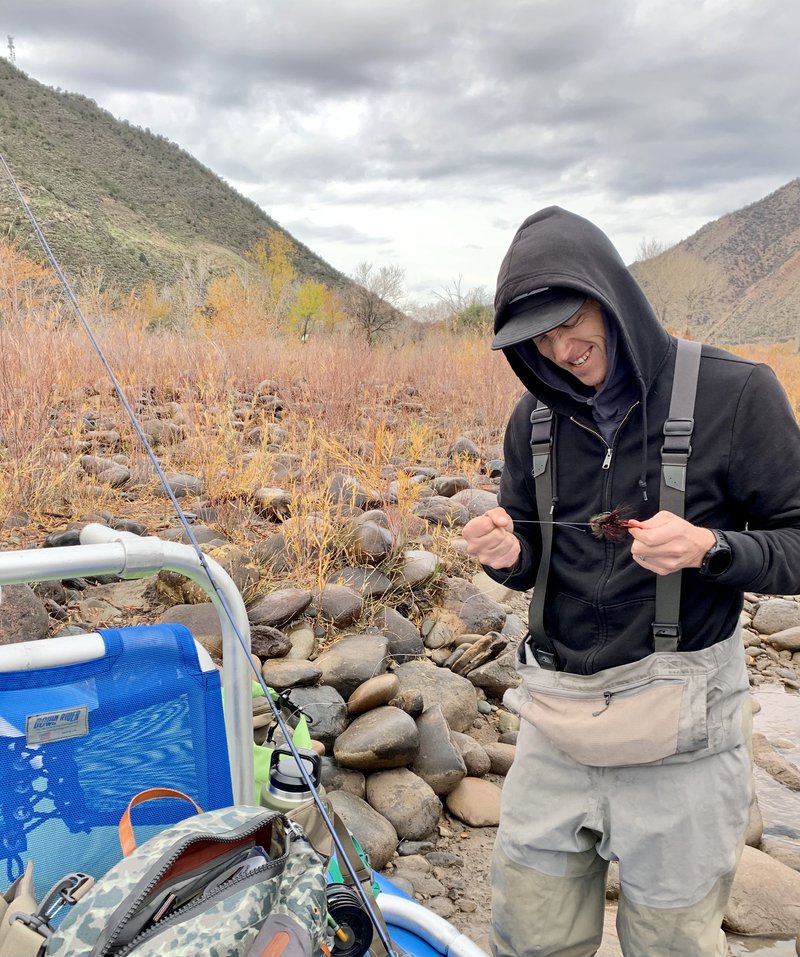Summer is a time of possibility where just about every fly in your box will fool fish and every style of fishing is productive. Late fall and early winter on the other hand, can feel limited with reduced flows, decreased bug life and increasingly sluggish trout. While nymphing with small midge and baetis patterns is a staple during this time, it’s by no means the only viable tactic. Streamers, dry flies and dry droppers still have a seat at the table but require minor adjustments to your approach.
For every angler that cringes at the idea of watching an indicator for the next few months, you’re not alone and we’re going to tell you how to effectively fish various setups during the late fall and winter.

Nymph Setups: If you’re like us, you have a love hate relationship with nymphing. You love it because it’s productive and hate it because watching an indicator all day is far from exciting. Regardless, it’s a highly productive tactic during the cold months and one that every angler should have in their playbook. Compared to the summer, nymphing becomes a delicate art when flows are low and trout are selective and skittish. With the exception of a few large freestone rivers, lighter tippet (5x and 6x) is recommended. Yarn indicators are a great alternative to thingamabobbers as they create less surface disturbance and are more sensitive to subtle takes. When it comes to weight and depth, you’ll want to focus on using the appropriate amount of split shot to get your flies into the deepest water column where trout stack up to conserve energy. Snagging the bottom of the river is a good sign your flies are drifting through the deepest water column. If you see trout feeding closer to the surface, drop some weight and lower your indicator, depending on the magnitude of the change in depth.
Dry Droppers: When we think about fishing dry droppers during the cold months, it’s less of an attempt to fool trout on the surface than it is an alternative nymph setup when fishing shallow water or targeting spooky trout. Your dry fly will act as your indicator and pattern selection is important. You don’t want a fly so small that it can’t carry the weight of multiple nymphs and you don’t want one so large that it defeats the purpose of being a delicate alternative to a bobber. We’ve found that a #16 Hippie Stomper and #14 Amy’s Ant straddles that line perfectly. These flies are buoyant enough to tow multiple nymphs and split shot while maintaining a low profile. The second part of the equation is using enough tippet between your dry fly and nymphs to get your flies into the deeper water columns. While it can depend on the depth of the river, we tend to use 24” – 36” of tippet to our first nymph and 10” – 12” of tippet to our second nymph. If you need to get your flies down quickly, either lead with a tungsten bead nymph or apply split shot above your first nymph.
Dry Flies: Prime dry fly season is behind us but that doesn’t mean trout aren’t looking up. Midges are active throughout the winter and BWOs tend to linger into December on certain tailwaters. Surface feeding can be hit or miss depending on weather conditions but when trout are rising, it’s a great opportunity to ditch the heavy weight setups. Now, before you get too excited, fooling trout with a dry fly during the cold months is far more difficult than other times of the year, due to low flows and gin clear water. Trout are easily deterred by sloppy casts and large tippet. Ensuring your leader is at least 9 ft long and downsizing your tippet to 6x fluorocarbon will enable you to make cleaner and more delicate presentations. Positioning yourself in a good position to make a clean cast and drift while keeping out of the trout’s line of vision is critical and can be difficult. While slightly unconventional, standing upstream of the rising trout, casting downstream and slowly feeding out line is a tactic we’ve found to be highly effective.
Streamers: Streamers and fall go together like peanut butter and jelly and after riding that high for several months, it can be tough to put the streamer rod away when air and water temps drop. The good thing is you don’t have to! Trout will still chase and eat baitfish, leeches and small trout during the winter. The downside to fishing streamers during the winter is stripping a cold, wet line. Your hands are cold already and touching a wet line doesn’t help the situation. To avoid this, wear nitrile gloves. While they won’t necessarily keep your hands warm, they will keep your hands dry and will protect the slime coat on trout. Once your hands are taken care of, it’s all about dialing in your retrieval. Trout are sluggish in cold water and don’t have the energy to chase streamers like they do during the warmer months. As a result, slow retrieves with long pauses are ideal. Dead drifting streamers through deep pools and runs is another approach if you can’t get trout to chase.
